Wu Shulian Chinese University Rankings 2019( Chinese and English)
武书连2019中国大学排行榜发布
“Chinese University Evaluation 2019” project, chaired by Wu Shulian, the leader of the “Chinese University Evaluation Research Group” of China Academy of Management Science, has been completed in March 2019 and its achievement entitled “Choose University & Major – Guidelines for GAOKAO in 2019 ” was published by China Statistics Press. This series of books have been published by China Statistics Press for 17 years in a row, which are widely acclaimed by university candidates and have extensive social influence.
The subjects ofWu Shulian’sChinese University Rankings 2019 are 758 state-funded general undergraduate universities.
Evaluation indicators applied in “Chinese University Evaluation 2019” include ‘The Overall Rankings of Chinese Universities’, ‘ Natural Science Rankings’, ‘Social Science Rankings’ ‘Rankings by subject: science, engineering, agronomy, medicine, philosophy, economics, law, education, literature, history, management and art’, rankings of 560 undergraduate majors. In addition, ‘Chinese University Selection Priority Rankings’, ‘Graduate Employment Quality Rankings’, ‘UndergraduateEnrollmentRate Rankings’, ‘Freshmen Quality Rankings, ‘Teachers’ Average Academic Level Rankings’, and ‘Teachers’ Performance Rankings are also taken into consideration.
I. Modification to “Chinese University Evaluation 2019” indicators
1. Undergraduate cultivation: ‘Art performance Awards Granted by the Ministry of Education ‘has been added as an indicator, which includes University Arts Education Research Paper Award, Arts Performance Award, Outstanding Program Creation Award, Art Practice Workshop Award, Art Works Award.
2. Social science research: academic works and other-citations have been added. The academic works originate from “Chinese Academic Book Citation Indexes” of Nanjing University, and the citations originate from SCD citation database.
II. Top three in Chinese University Rankings 2019: Tsinghua University, Zhejiang University, and Peking University
In 1993, Peking University ranked the first place, according to Wu Shulian’s first Chinese University Ranking that regarded comprehensive strength of the universities as the main indicator. From 1997 to 2010, Tsinghua University has held on to the number one spot for fourteen years in a row, ; from 2011 to 2013, Zhejiang University won two titles in a row; in 2014 and 2015, Peking University won the first place, while it was Tsinghua University from 2016 to 2019.
Total scores of the top 10 inChinese University Rankings 2019are as follows: 1.Tsinghua University, 145.69; 2. Zhejiang University, 140.67; 3. Peking University, 140.37; 4. Shanghai JiaoTong University, 114.27; 5. Wuhan University, 96.96; 6. Nanjing University, 95.69; 7. Fudan University, 94.64; 8. Huazhong University of Science and Technology, 92.07; 9. Sichuan University, 85.70; 10. Jilin University, 85.58.
Wuhan University has risen to the fifth place inChinese University Rankings 2019, which is its best performance since 1993. The five-year ranking of Wuhan University is:7 in 2015,7 in 2016,7 in 2017,7 in 2018, and 5 in 2019
III. Top three in Graduate Employment Quality Rankings 2019: Tsinghua University, Peking University, University of Science and Technology of China
InGraduate Employment Quality Rankings 2019, Tsinghua University topped the list with 3.3999 points; Peking University ranked second with 3.2835 points, while University of Science and Technology of China ranked third with 3.1313 points. Universities from the 4th to the 10th are: No 4 Beihang University, No 5 Shanghai Tech University, No 6 Nanjing University, No 7 Shanghai Jiaotong University, No 8 Fudan University, No 9 University of Electronic Science and Technology, No 10 Beijing University of Posts and Telecommunications.
IV. Top three in Undergraduate Enrollment Rate Rankings 2019: Tsinghua University, Peking University, University of Science and Technology of China
InUndergraduate Enrollment Rate Rankings 2019, Tsinghua University topped the list with 81.90%, Peking University ranked second with 75.16%, while University of Science and Technology of China ranked third with 73.87%. The universities ranked from 4 to 10 were: No. 4 Beihang University, No. 5 Shanghai Tech University, No. 6 Fudan University, No. 7 Shanghai JiaoTong University, No. 8 Beijing University of Posts and Telecommunications, No. 9 Renmin University of China, and No. 10 University of Electronic Science and Technology of China.
V. Top three in Teachers’ Average Academic Level Rankings 2019: University of Science and Technology of China, Nanjing University, and Peking University
InTeachers’ Average Academic Level Rankings 2019, University of Science and Technology of China ranked first with 4.2278 points, Nanjing University second with 3.7087, Peking University third with 3.4719. The universities ranked 4 to 10 were: No. 4 Renmin University of China, No. 5 Nankai University, No. 6 Shanghai JiaoTong University, No. 7 Zhejiang University, No. 8 Fudan University, No. 9 Tsinghua University, and No. 10 Beijing University of Chemical Technology.
VI. Top three in Teachers’ Teaching-Research Efficiency Rankings 2019: University of Science and Technology of China, Nanjing University, and Renmin University of China
InTeachers’ Teaching-Research Efficiency Rankings 2019, University of Science and Technology of China ranked first with 4.2709 points, Nanjing University second with 3.8192, Renmin University of China third with 3.7184. The universities ranking 4 to 10 were: No. 4 Beijing Normal University, No. 5 Central Conservatory of Music, No. 6 Peking University, No. 7 Nankai University, No. 8 Shanghai JiaoTong University, No. 9 Southern University of Science and Technology, and No. 10 China Agricultural University.
VII. Top three inFreshmen Quality Rankings 2019: Tsinghua University, Peking University, and University of Science and Technology of China
InFreshmen Quality Rankings 2019, Tsinghua University ranked first with 1.3507, Peking University second with 1.3501, University of Science and Technology of China third with 1.3281. The universities ranked 4 to 10 were: No. 4 Fudan University, No. 5 Shanghai JiaoTong University, No. 6 Nanjing University, No. 7 Zhejiang University, No. 8 Renmin University of China, No. 9 Shanghai University of Finance and Economics, and No. 10 Tongji University.
VIII. Top three inChinese University Selection Priority Rankings 2019: University of Science and Technology of China, Nanjing University, and Peking University
InChinese University Selection Priority Rankings 2019, University of Science and Technology of China ranked first with 1.67, Nanjing University second with 3.33, Peking University third with 3.67. The universities ranked 4 to 10 were: No. 4 Shanghai JiaoTong University, No. 5 Renmin University of China, No. 6 Tsinghua University, No. 7 Fudan University, No. 8 Zhejiang University, No. 9 Nankai University, and No. 10 Beihang University.
IX. Top three among 28 Chinese first-class universities: University of Science and Technology, Peking University, and Nanjing University
The criteria ofChinese first-classuniversities in 2019: In the evaluation of Chinese universities, the universities should satisfy the following three conditions simultaneously. 1. The Graduate Employment Quality ranks among the top 50 universities nationwide. 2. TheTeachers’Average Academic Levelranks among the top 50 universities nationwide. 3. TheTeachers’ Teaching-Research Efficiencyranks among the top 50 universities nationwide.
The three scores of the above-mentioned criteria are added in ascending order. The lower the score is, the higher the ranking is. For the same score, the university having higher graduate employment quality ranks front.
According to the criteria, China has 28first-classuniversities in 2019, which is the same as the previous year.25 world-class construction universities and 3 world-class discipline universities included.
Wu Shulian 2019 Chinese First-Class Universities list (28 in total)
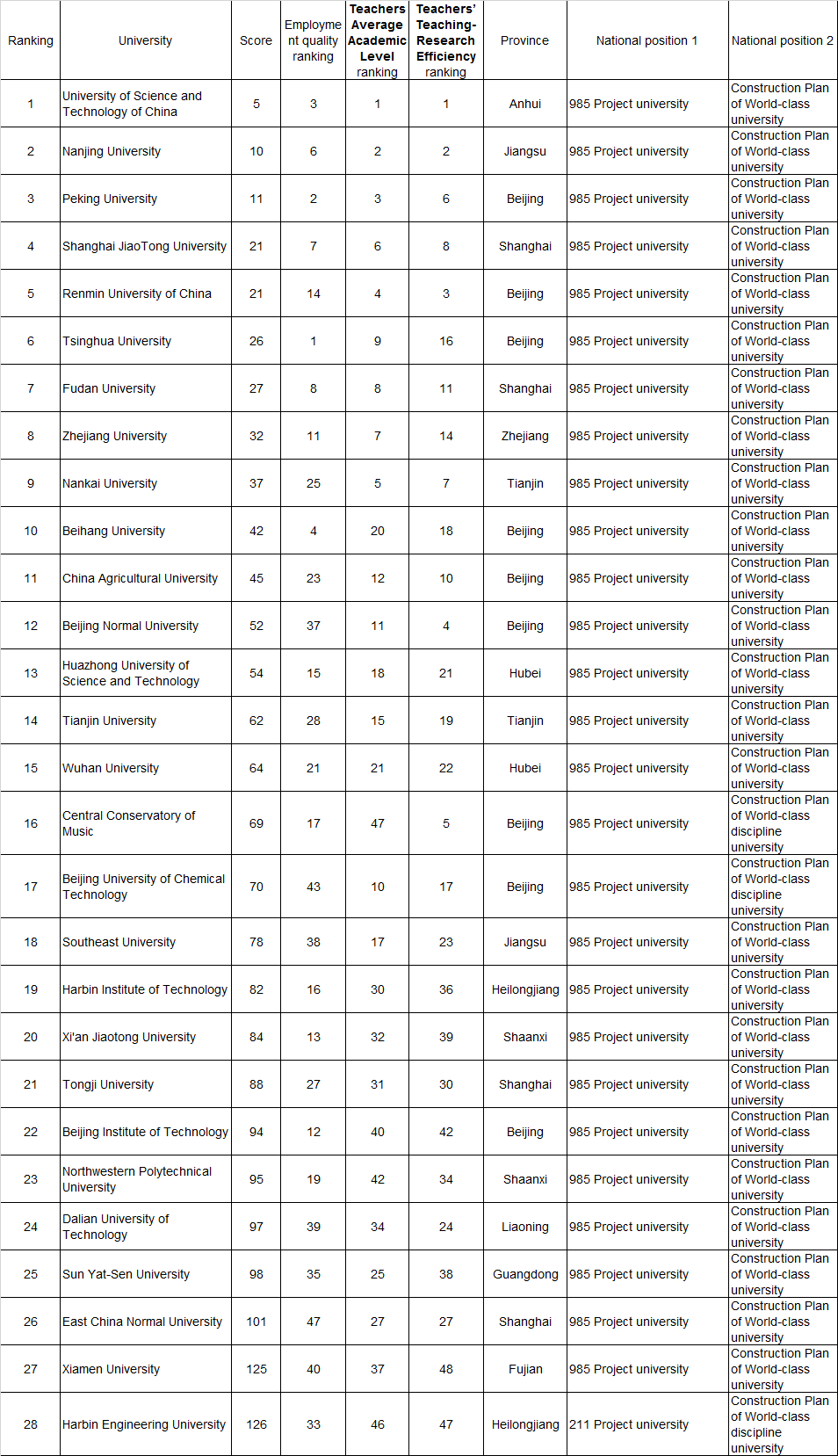
Southern University of Science and Technology, which was elected as one of Chinese first-class universities last year, failed to be elected because of sharp drop in enrollment rate in 2017.
X. Top three among 38 research-oriented universities: Tsinghua University, Peking University and Zhejiang University
The criteria of research-oriented universities in 2019 were the same as those of the previous year: the scientific research scores of all universities in the country were listed in descending order, with the top 5% being research-oriented universities.
A total of 38 universities satisfy the above condition. Among the 38 research-oriented universities, 34 are world-class universities and 3 are world-class disciplines. For the second year in a row, Jiangsu University, a non-double first-class university, joined the list.Research-oriented universities are divided into research type 1 and research type 2.The teachers’ average academic level of the research type 1 is higher than that of research-oriented universities, and the teachers’ academic level of the research type 2 is lower than that of research-oriented universities. The Ranking and the Grade of the Key Index about the 38 Research-oriented Universities in Wu Shulian 2019
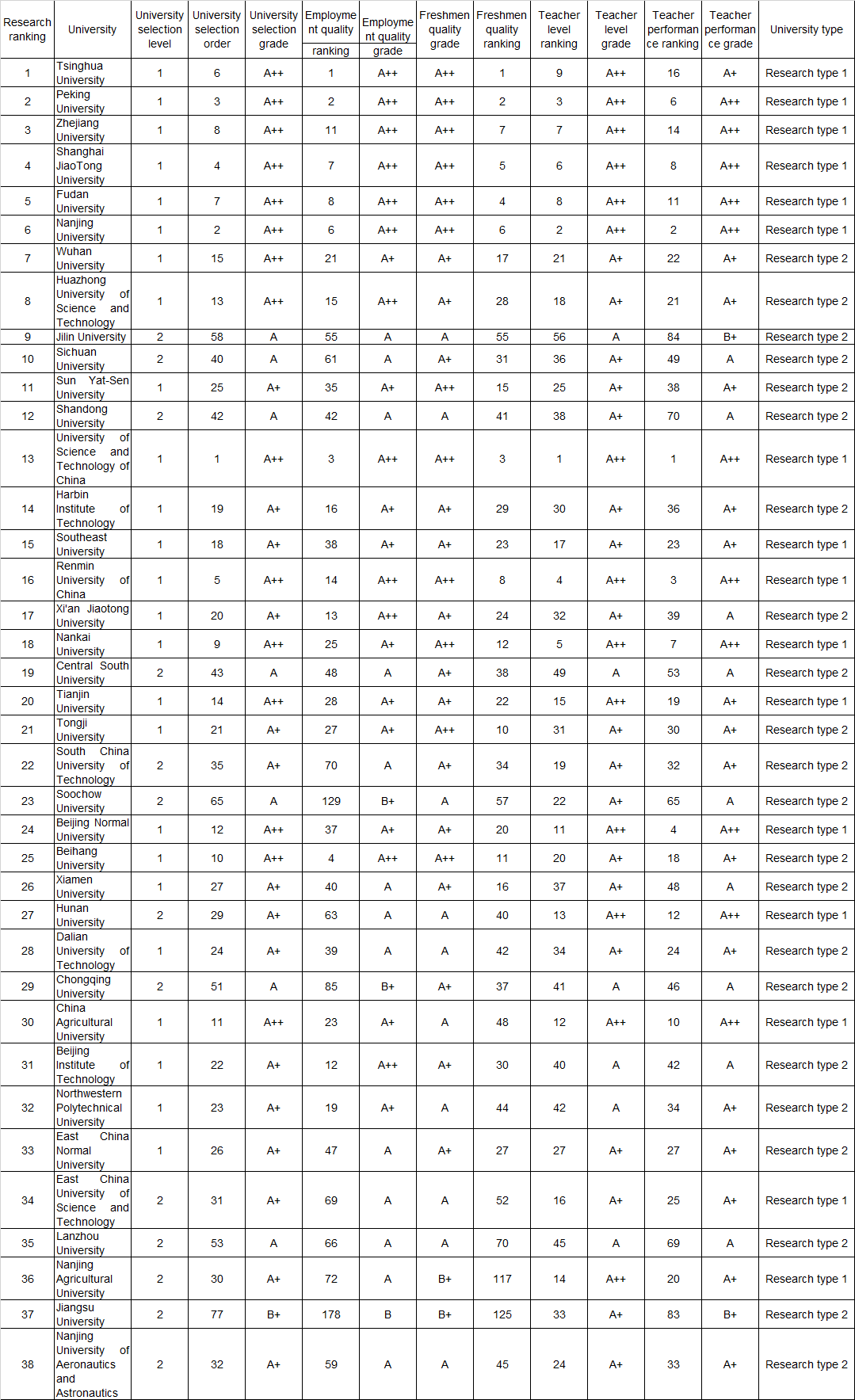
The standard definitions of the indicators in the above table are as follows (the following tables are the same as those in the following tables):
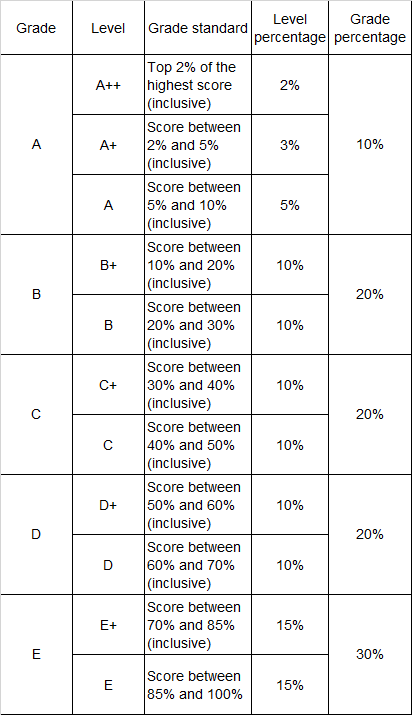
XI. 17 non-double first-class universities enter the top 100 universities in China
In 2019, 17 non-double first-class universities entered the top 100 in terms of comprehensive strength.. The key indicators are shown in the table below.
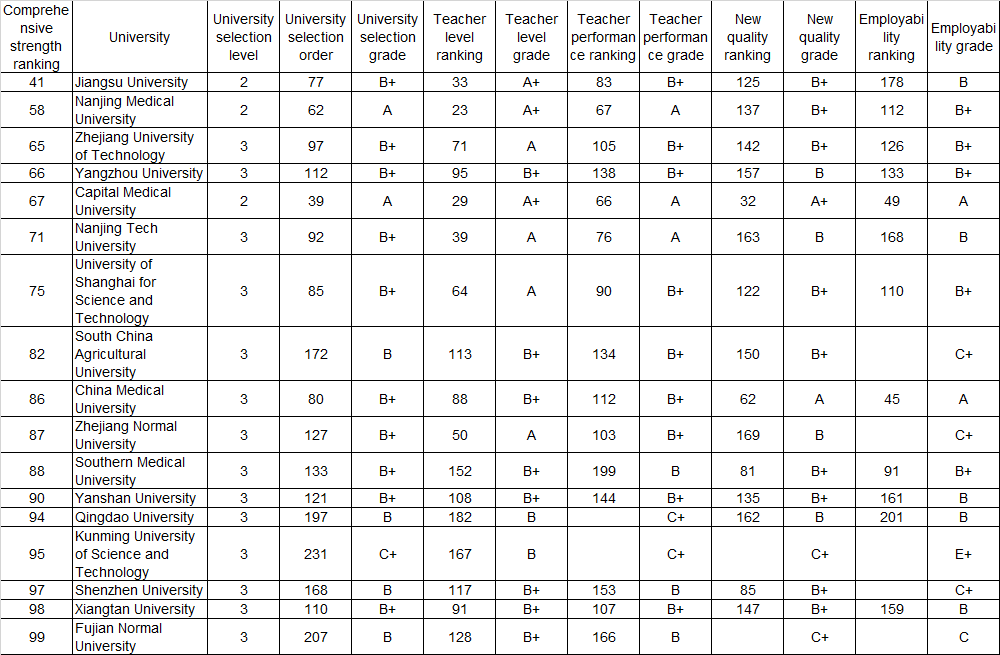
XII. Key indicators of 42 world-class construction universities
On September 20, 2017, the Ministry of Education, the Ministry of Finance, and the National Development and Reform Commission released a file [2017] No. 2 “Notice on the Publication of List of World-Class Universities and First-Class Discipline Construction Universities and Construction Disciplines” which announces that the goal of 42 universities is becoming world-class universities.
Key indicators of world-class construction universities are shown in the following table (excluding National University of Defense Technology)
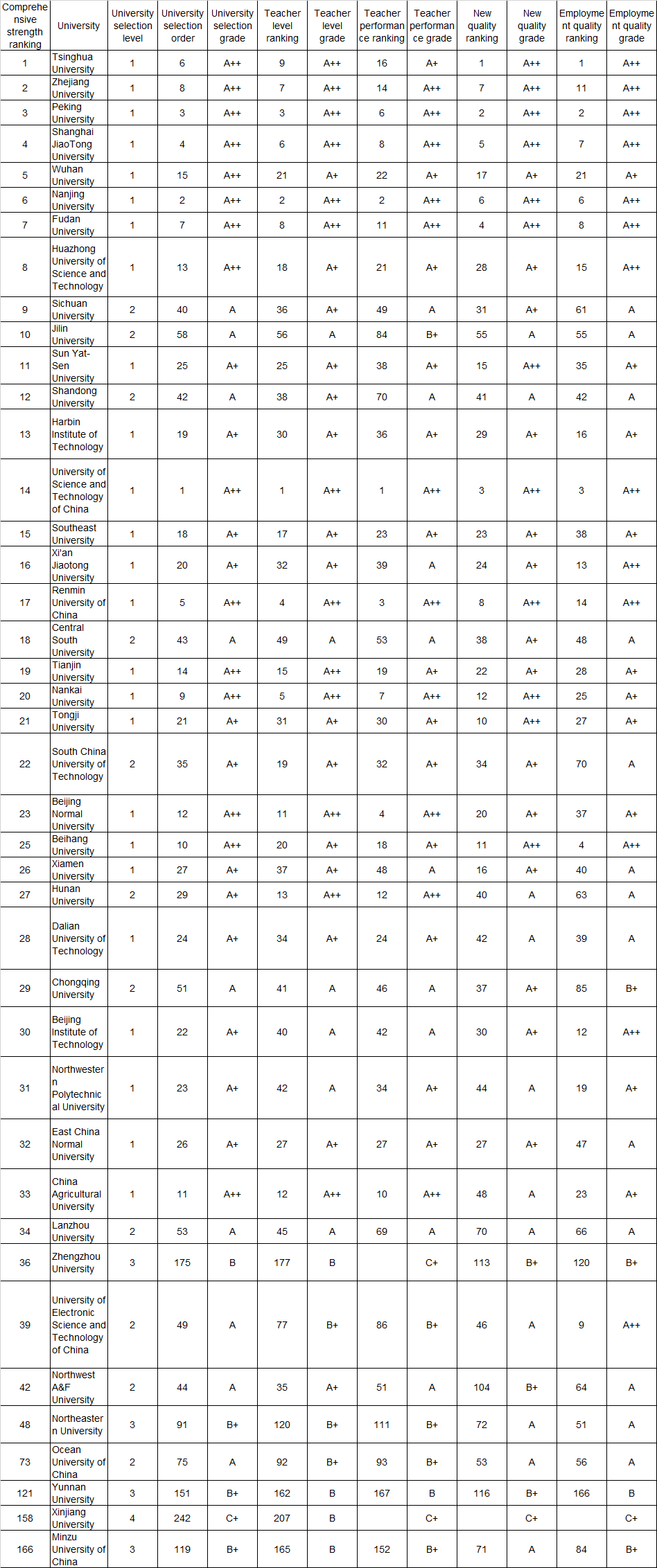
XIII. Zhejiang University ranked first in the total score of natural sciences, and Renmin University of China ranked first in the total score of social sciences
(1) Zhejiang University ranked first, Tsinghua University ranked second, and Shanghai JiaoTong University ranked third in the rankings of four natural sciences including science, engineering, agronomy and medicine.
Natural Science No. 1: Zhejiang University
Science No. 1: Peking University
Engineering No. 1: Tsinghua University
Agronomy No. 1: China Agricultural University
Medicine No. 1: Shanghai JiaoTong University
(2) Renmin University of China ranked first, Peking University ranked second, and Wuhan University ranked third in the rankings of eight social sciences including philosophy, economics, law, education, literature, history, management and art.
Social Science No. 1: Renmin University of China
Philosophy No. 1: Renmin University of China
Economics No. 1: Renmin University of China
Law No. 1: Renmin University of China
Education: Beijing Normal University
Literature No. 1: Peking University
History No. 1: Peking University
Management No. 1: Renmin University of China
Art No. 1: Nanjing University of the Arts
XIV. The top three universities are Peking University, Tsinghua University, Renmin University of China, which gain great popularity among undergraduate candidates when they choose majors.Choose University
XV. In 2019, the number of universities that entering the top 100 Chinese comprehensive strength University in all provinces, cities, autonomous regions.
The number of universities that entering the top 100 Chinese comprehensive strength University in all provinces, cities, autonomous regions are shown in the following table. The ranking is ranked by the number of universities entering the top 100, with the same number in ascending order of the average ranking.
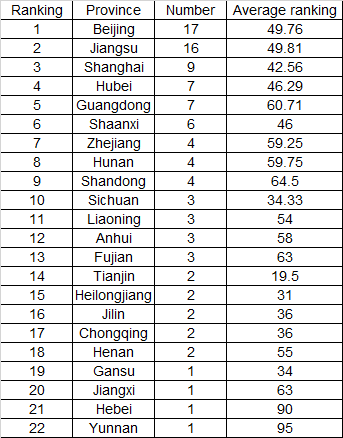
XVI. Comprehensive Strength Rankings of Chinese Universities 2019
Comprehensive Strength Rankings of Chinese Universities 2019are shown in the following table. Suzhou University ranked 24, the best place for the non-world-class construction universities. Jiangsu University ranked 41, the best ranking for non-world-class discipline construction universities.
Shenzhen University, founded in 1983, entered the top 100 Chinese universities with its comprehensive strength in 2019 after 35 years of puzzling efforts.. The comprehensive strength rankings of Shenzhen University in the last five years were: No. 125 in 2015, No. 121 in 2016, No. 115 in 2017, and No. 106 in 2018, and No. 97 in 2019.
Wu Shulian Top 100 Comprehensive Strength Rankings of Chinese Universities 2019

Wu Shulian Top 101-200 Comprehensive Strength Rankings of Chinese universities 2019

Wu Shulian Top 201-300 Comprehensive Strength Rankings of Chinese Universities 2019

XVII. Wu Shulian Provincial Comprehensive Strength Rankings of Chinese Universities 2019
(No ranking behind No. 600, ranking in no particular order)
(I)Provincial Comprehensive Strength Rankings of Universities in North China 2019
North China includes Beijing, Tianjin, Hebei, Shanxi, and Inner Mongolia Autonomous Region, in a total of five provincial administrative regions.
1. Comprehensive Strength Rankings of Universities in Beijing 2019
54 general undergraduate universities in Beijing were evaluated in 2019. The teachers’ academic level of universities in Beijing was 2.0259, ranking first in China. The teachers’ performance was 2.1241, ranking first in China. 17099 doctoral students graduated in 2018, ranking first in China. 111403 undergraduates graduated, ranking 11 in China. 70402 postgraduates graduated in 2017, ranking first in China.

2. Comprehensive Strength Rankings of Universities in Tianjin 2019
18 general undergraduate universities in Tianjin were evaluated in 2019. The teachers’ academic level of universities in Tianjin was 1.3958, ranking 5 in China. The teachers’ performance was 1.3323, ranking 4 in China. 2455 doctoral students graduated in 2018, ranking 14 in China. 63142 undergraduates graduated, ranking 23 in China. 17230 postgraduates graduated in 2017, ranking 15 in China.
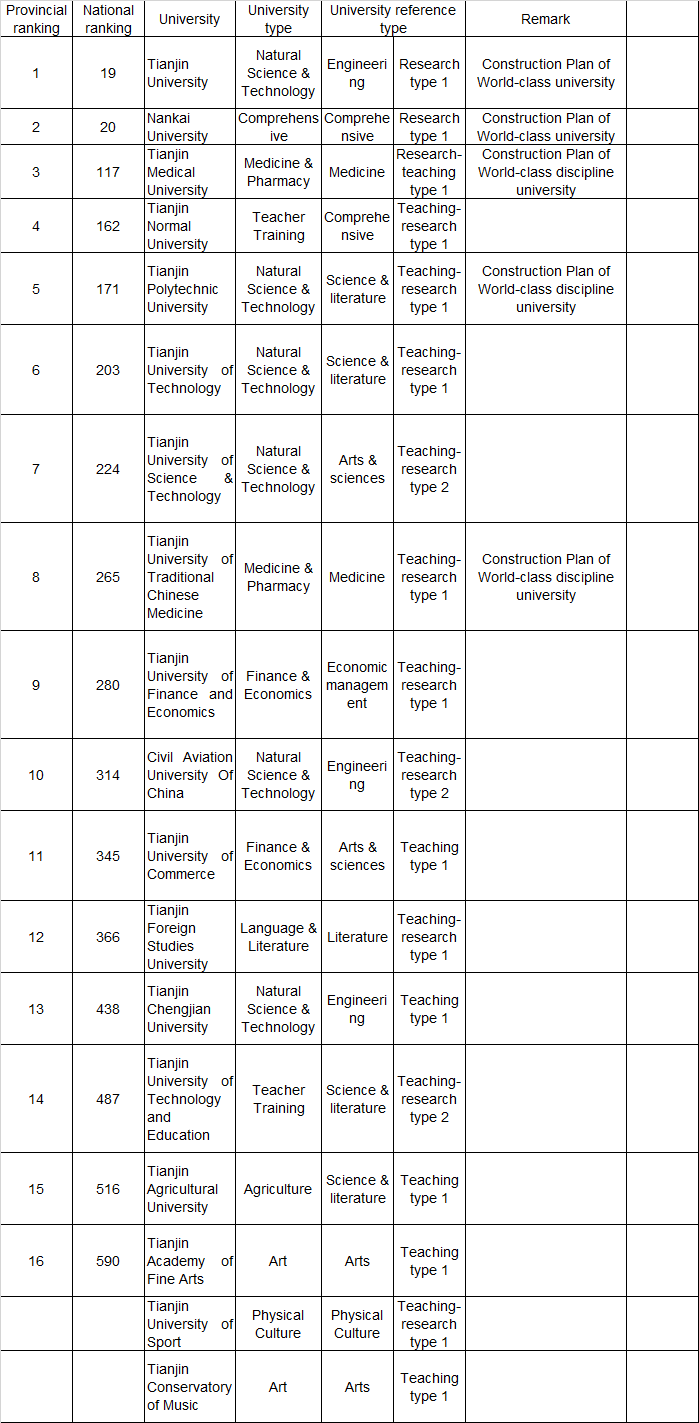
3. Comprehensive Strength Rankings of Universities in Hebei 2019
33 general undergraduate universities in Hebei were evaluated in 2019. The teachers’ academic level of universities in Hebei was 0.3855, ranking 25 in China. The teachers’ performance was 0.5364, ranking 27 in China. 746 doctoral students graduated in 2018, ranking 20 in China. 83160 undergraduates graduated, ranking 13 in China. 14054 postgraduates graduated in 2017, ranking 17 in China.

4. Comprehensive Strength Rankings of Universities in Shanxi 2019
21 general undergraduate universities in Shanxi were evaluated in 2019. The teachers’ academic level of universities in Shanxi was 0.4342, ranking 22 in China. The teachers’ performance was 0.5928, ranking 21 in China. 720 doctoral students graduated in 2018, ranking 20 in China. 83160 undergraduates graduated, ranking 18 in China. 10136 postgraduates graduated in 2017, ranking 23 in China.
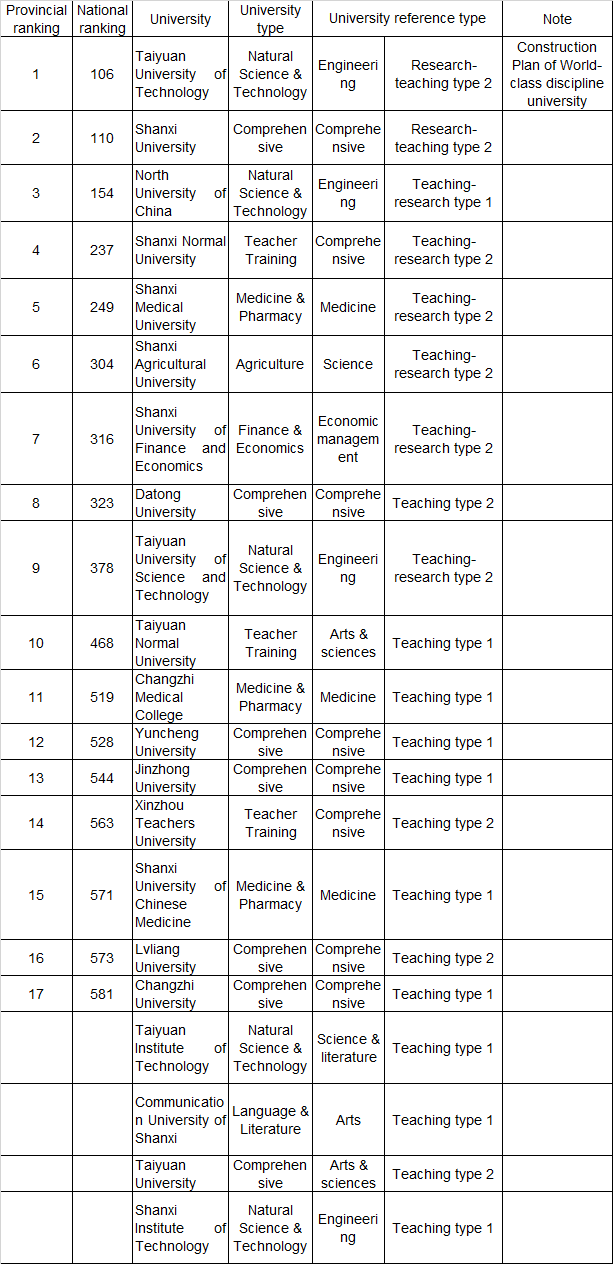
5. Comprehensive Strength Rankings of Universities in Inner Mongolia 2019
13 general undergraduate universities in Inner Mongolia were evaluated in 2019. The teachers’ academic level of universities in Inner Mongolia was 0.2620, ranking 30 in China. The teachers’ performance was 0.4169, ranking 31 in China. 347 doctoral students graduated in 2018, ranking 23 in China. 55935 undergraduates graduated, ranking 25 in China. 6436 postgraduates graduated in 2017, ranking 26 in China.
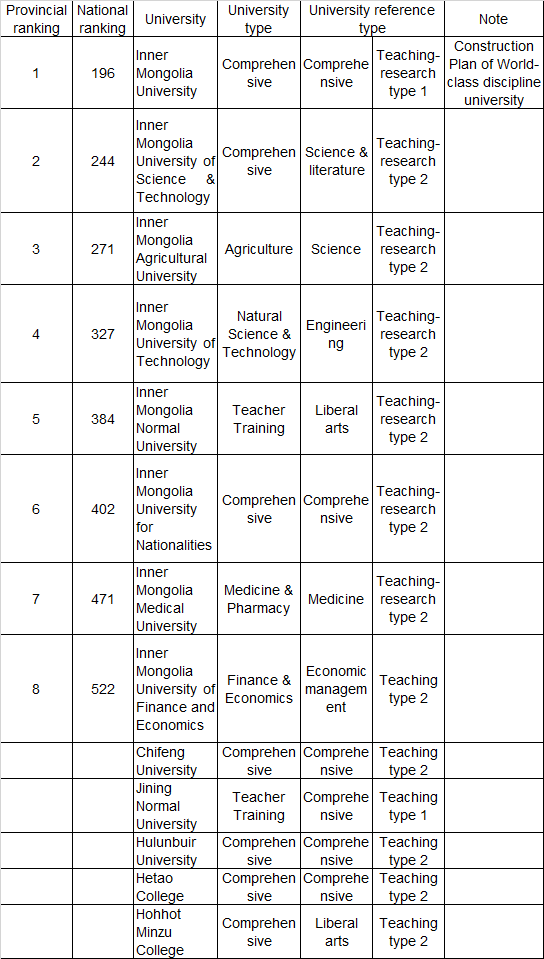
(II) Provincial Comprehensive Strength Rankings of Universities in Northeast China 2019
Northeast China includes Liaoning, Jilin, and Heilongjiang, in a total of three provincial administrative regions.
1. Comprehensive Strength Rankings of Universities in Liaoning 2019
39 general undergraduate universities in Liaoning were evaluated in 2019. The teachers’ academic level of universities in Liaoning was 0.7265, ranking 17 in China. The teachers’ performance was 0.8711, ranking 14 in China. 3911 doctoral students graduated in 2018, ranking 7 in China. 136380 undergraduates graduated, ranking 7 in China. 31518 postgraduates graduated in 2017, ranking 6 in China.

2. Comprehensive Strength Rankings of Universities in Jilin 2019
24 general undergraduate universities in Jilin were evaluated in 2019. The teachers’ academic level of universities in Jilin was 0.7868, ranking 14 in China. The teachers’ performance was 0.8495, ranking 15 in China. 2831 doctoral students graduated in 2018, ranking 12 in China. 84147 undergraduates graduated, ranking 17 in China. 19134 postgraduates graduated in 2017, ranking 13 in China.
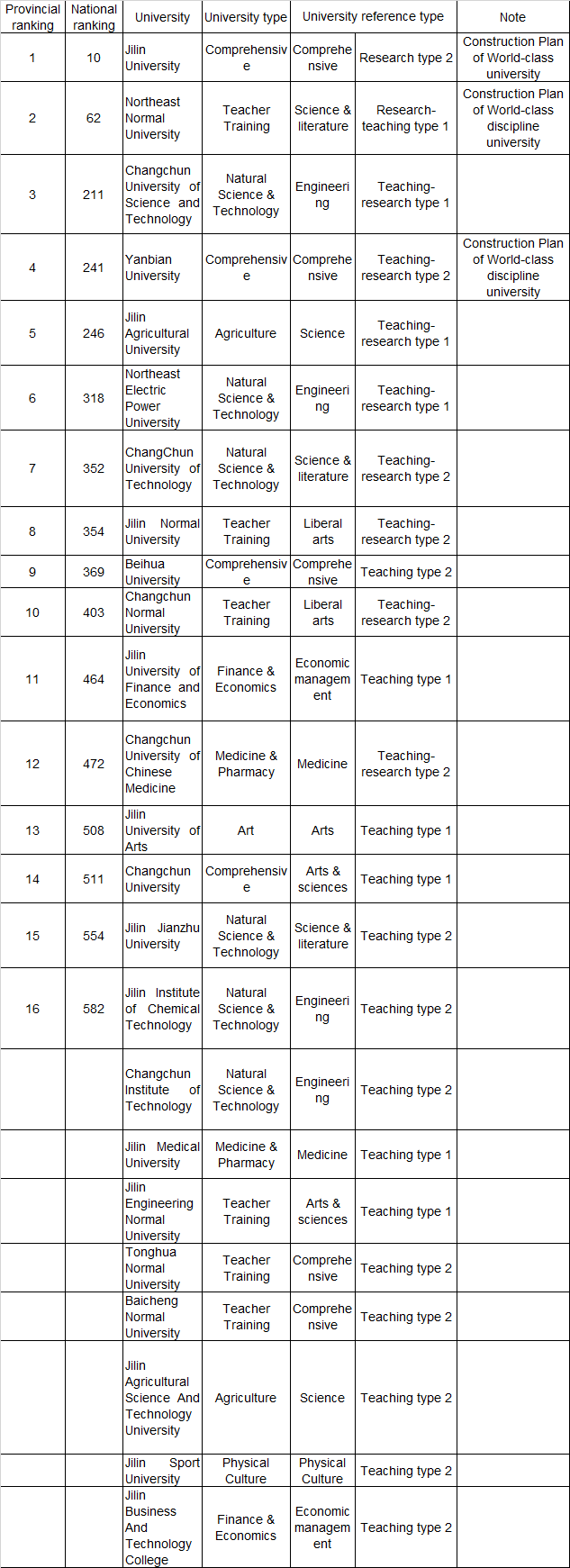
3. Comprehensive Strength Rankings of Universities in Heilongjiang 2019
26 general undergraduate universities in Heilongjiang were evaluated in 2019. The teachers’ academic level of universities in Heilongjiang was 0.8818, ranking 12 in China. The teachers’ performance was 0.9141, ranking 12 in China. 3238 doctoral students graduated in 2018, ranking 10 in China. 107325 undergraduates graduated, ranking 12 in China. 19725 postgraduates graduated in 2017, ranking 12 in China.
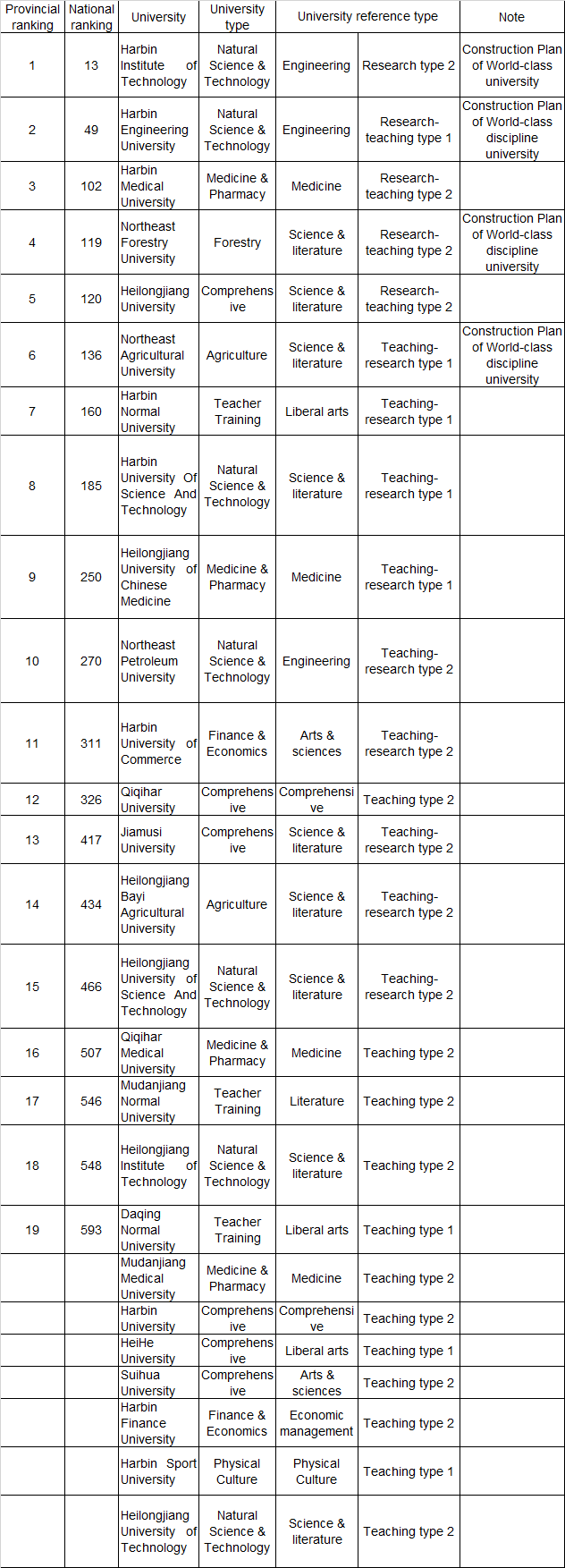
(III) Provincial Comprehensive Strength Rankings of Universities in East China 2019
East China includes Shanghai, Jiangsu, Zhejiang, Anhui, Fujian, Jiangxi, and Shandong, in a total of seven provincial administrative regions.
1. Comprehensive Strength Rankings of Universities in Shanghai 2019
29 general undergraduate universities in Shanghai were evaluated in 2019. The teachers’ academic level in Shanghai was 1.9373, ranking 2 in China. The teachers’ performance was 1.8871, ranking 2 in China. 8201 doctoral students graduated in 2018, ranking 2 in China. 80825 undergraduates graduated, ranking 20 in China. 42284 postgraduates graduated in 2017, ranking 3 in China.

2. Comprehensive Strength Rankings of Universities in Jiangsu 2019
43 general undergraduate universities in Jiangsu were evaluated in 2019. The teachers’ academic level of universities in Jiangsu was 1.6664, ranking 3 in China. The teachers’ performance was 1.5010, ranking 3 in China. 7595 doctoral students graduated in 2018, ranking 3 in China. 173983 undergraduates graduated, ranking 3 in China. 49725 postgraduates graduated in 2017, ranking 2 in China.

3. Comprehensive Strength Rankings of Universities in Zhejiang 2019
28 general undergraduate universities in Zhejiang were evaluated in 2019. The teachers’ academic level of universities in Zhejiang was 1.4578, ranking 4 in China. The teachers’ performance was 1.2706, ranking 5 in China. 3126 doctoral students graduated in 2018, ranking 11 in China. 92389 undergraduates graduated, ranking 14 in China. 19856 postgraduates graduated in 2017, ranking 11 in China.
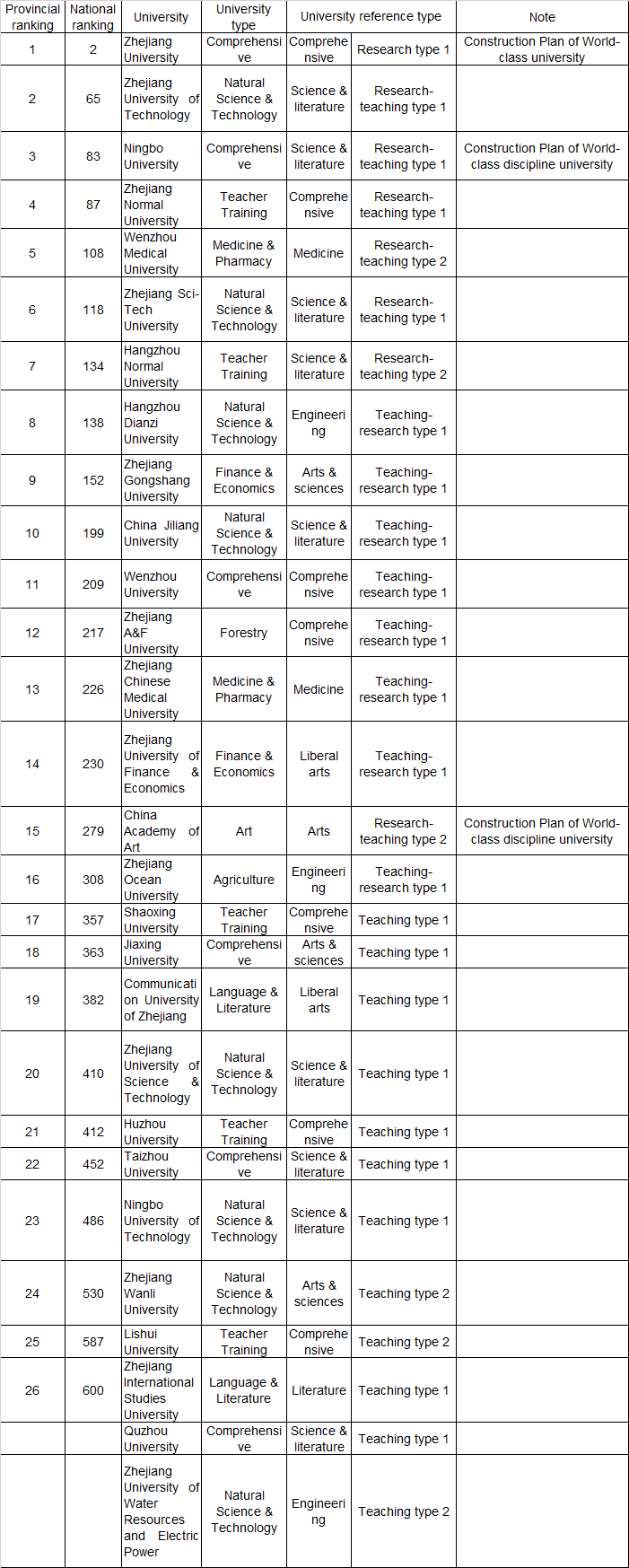
4. Comprehensive Strength Rankings of Universities in Anhui 2019
29 general undergraduate universities in Anhui were evaluated in 2019. The teachers’ academic level of universities in Anhui was 0.9009, ranking 11 in China. The teachers’ performance was 0.9334, ranking 11 in China. 1496 doctoral students graduated in 2018, ranking 17 in China. 123877 undergraduates graduated, ranking 10 in China. 16594 postgraduates graduated in 2017, ranking 16 in China.
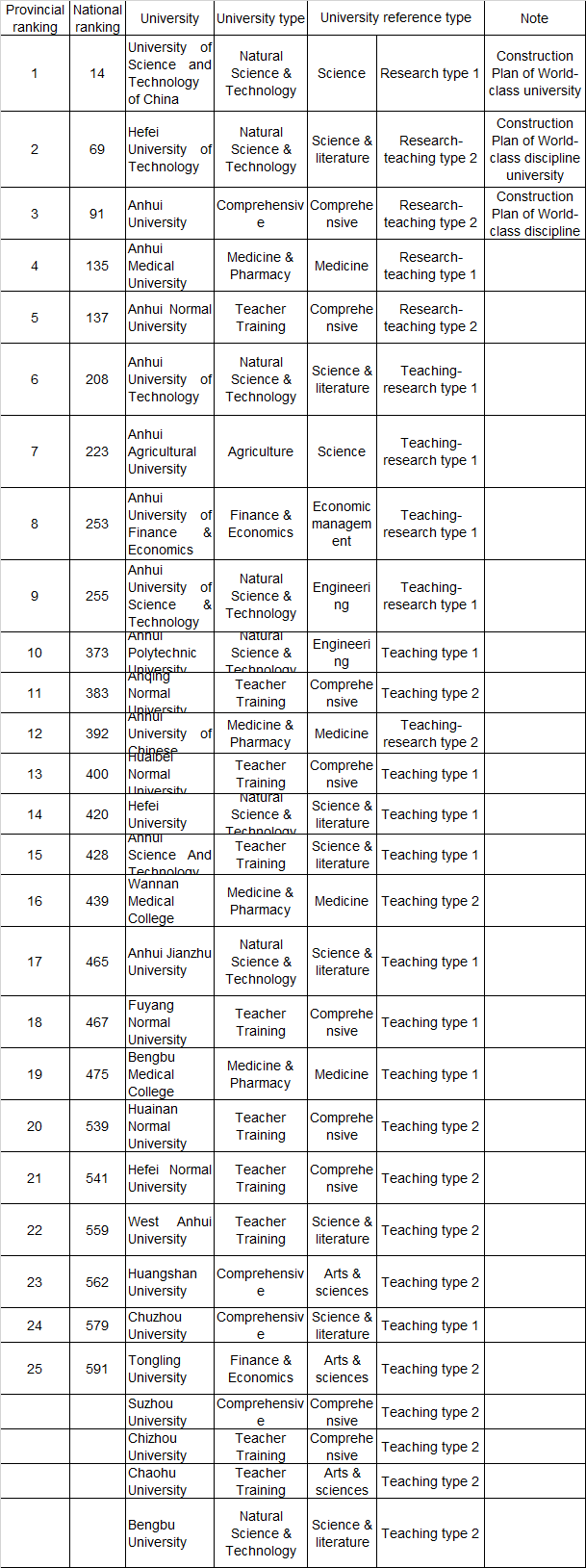
5. Comprehensive Strength Rankings of Universities in Fujian 2019
19 general undergraduate universities in Fujian were evaluated in 2019. The teachers’ academic level of universities in Fujian was 0.8707, ranking 13 in China. The teachers’ performance was 0.8790, ranking 13 in China. 1556 doctoral students graduated in 2018, ranking 16 in China. 82971 undergraduates graduated, ranking 19 in China. 13541 postgraduates graduated in 2017, ranking 18 in China.
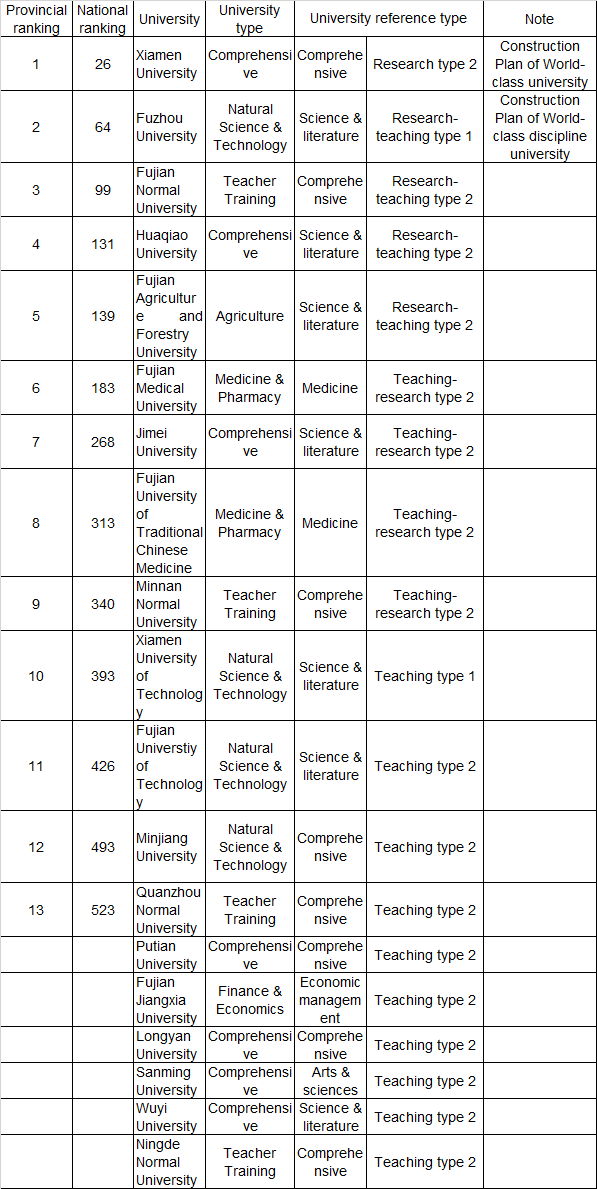
6. Comprehensive Strength Rankings of Universities in Jiangxi 2019
22 general undergraduate universities in Jiangxi were evaluated in 2019. The teachers’ academic level of universities in Jiangxi was 0.4378, ranking 21 in China. The teachers’ performance was 0.5680, ranking 23 in China. 300 doctoral students graduated in 2018, ranking 24 in China. 87668 undergraduates graduated, ranking 15 in China. 10656 postgraduates graduated in 2017, ranking 21 in China.
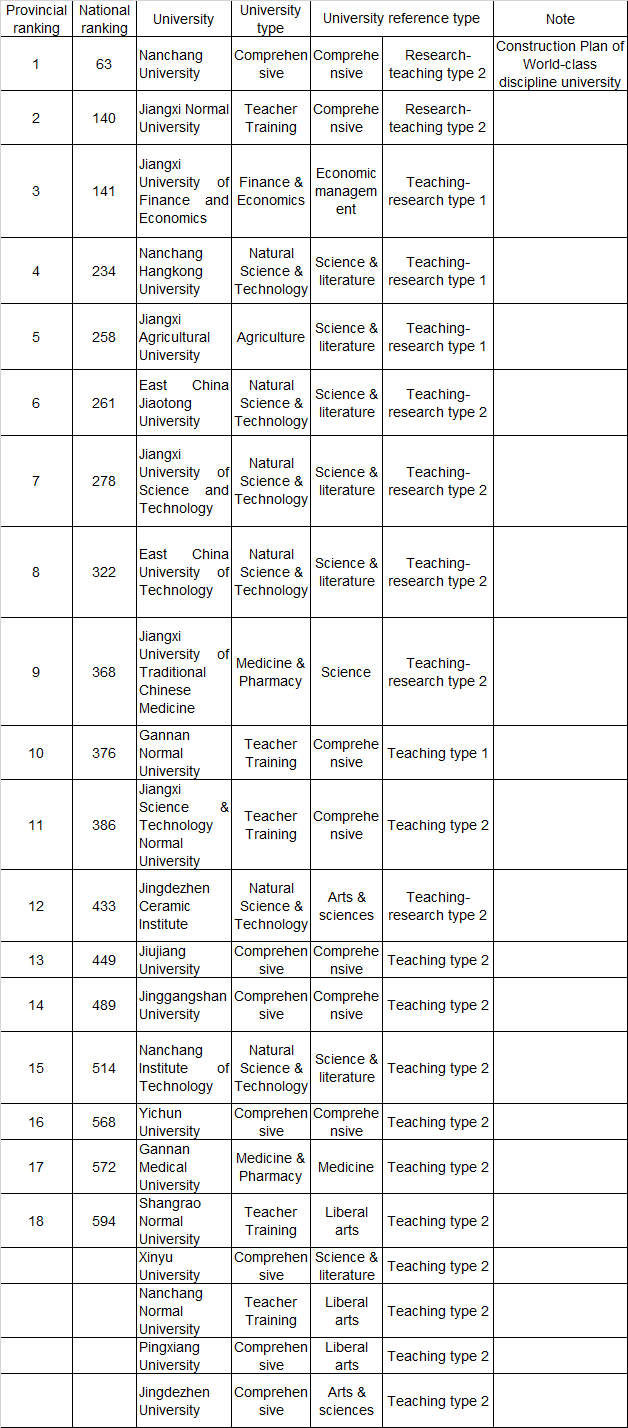
7. Comprehensive Strength Rankings of Universities in Shandong 2019
43 general undergraduate universities in Shandong were evaluated in 2019. The teachers’ academic level of universities in Shandong was 0.6817, ranking 18 in China. The teachers’ performance was 0.7297, ranking 18 in China. 2490 doctoral students graduated in 2018, ranking 13 in China. 208808 undergraduates graduated, ranking 1 in China. 26280 postgraduates graduated in 2017, ranking 9 in China.

(IV) Provincial Comprehensive Strength Rankings of Universities in Mid-South China 2019
Mid-South China includes Henan, Hubei, Hunan, Guangdong, Guangxi, and Hainan, in a total of 6 provincial administrative regions.
1. Comprehensive Strength Rankings of Universities in Henan 2019
33 general undergraduate universities in Henan were evaluated in 2019. The teachers’ academic level of universities in Henan was 0.4589, ranking 20 in China. The teachers’ performance was 0.5524, ranking 24 in China. 448 doctoral students graduated in 2018, ranking 22 in China. 181229 undergraduates graduated, ranking 2 in China. 13219 postgraduates graduated in 2017, ranking 19 in China.

2. Comprehensive Strength Rankings of Universities in Hubei 2019
34 general undergraduate universities in Hubei were evaluated in 2019. The teachers’ academic level of universities in Hubei was 1.1635, ranking 6 in China. The teachers’ performance was 1.1634, ranking 6 in China. 6326 doctoral students graduated in 2018, ranking 4 in China. 148486 undergraduates graduated, ranking 6 in China. 37100 postgraduates graduated in 2017, ranking 4 in China.

3. Comprehensive Strength Rankings ofUniversities in Hunan 2019
30 general undergraduate universities in Hunan were evaluated in 2019. The teachers’ academic level of universities in Hunan was 0.9081, ranking 10 in China. The teachers’ performance was 0.9374, ranking 10 in China. 3285 doctoral students graduated in 2018, ranking 9 in China. 127864 undergraduates graduated, ranking 9 in China. 22017 postgraduates graduated in 2017, ranking 10 in China.

4. Comprehensive Strength Rankings of Universities in Guangdong 2019
36 general undergraduate universities in Guangdong were evaluated in 2019. The teachers’ academic level of universities in Guangdong was 0.9889, ranking 8 in China. The teachers’ performance was 0.9542, ranking 9 in China. 4290 doctoral students graduated in 2018, ranking 6 in China. 166236 undergraduates graduated, ranking 4 in China. 29226 postgraduates graduated in 2017, ranking 8 in China.

5. Comprehensive Strength Rankings of Universities in Guangxi 2019
21 general undergraduate universities in Guangxi were evaluated in 2019. The teachers’ academic level of universities in Guangxi was 0.3875, ranking 24 in China. The teachers’ performance was 0.5021, ranking 28 in China. 270 doctoral students graduated in 2018, ranking 26 in China. 67359 undergraduates graduated, ranking 22 in China. 9988 postgraduates graduated in 2017, ranking 24 in China.
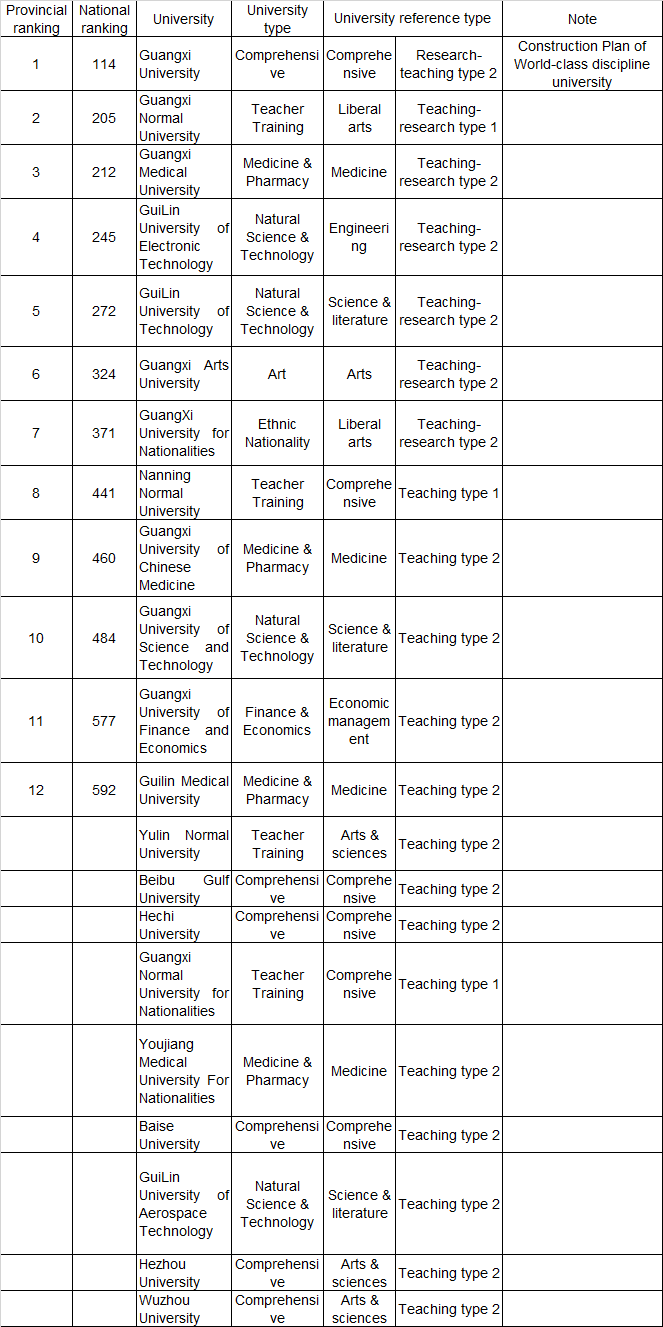
6. Comprehensive Strength Rankings of Universities in Hainan 2019
4 general undergraduate universities in Hainan were evaluated in 2019. The teachers’ academic level of universities in Hainan was 0.3878, ranking 26 in China. The teachers’ performance was 0.6131, ranking 19 in China. 57 doctoral students graduated in 2018, ranking 28 in China. 17387 undergraduates graduated, ranking 28 in China. 1590 postgraduates graduated in 2017, ranking 29 in China.
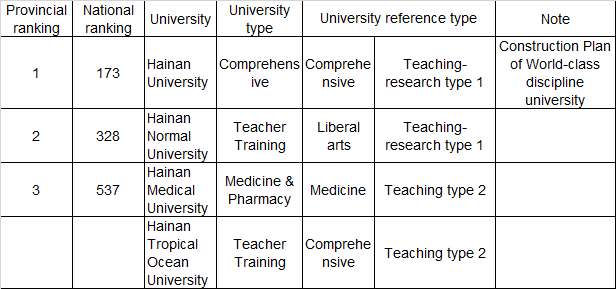
(V) Provincial Comprehensive Strength Rankings of Universities in Southwest China 2019
Southwest China includes Chongqing, Sichuan, Guizhou, Yunnan, and Tibet, in a total of five provincial administrative regions.
1. Comprehensive Strength Rankings of Universities in Chongqing 2019
16 general undergraduate universities in Chongqing were evaluated in 2019. The teachers’ academic level of universities in Chongqing was 0.9644, ranking 9 in China. The teachers’ performance was 0.9872, ranking 8 in China. 1610 doctoral students graduated in 2018, ranking 15 in China. 85656 undergraduates graduated, ranking 16 in China. 17384 postgraduates graduated in 2017, ranking 14 in China.
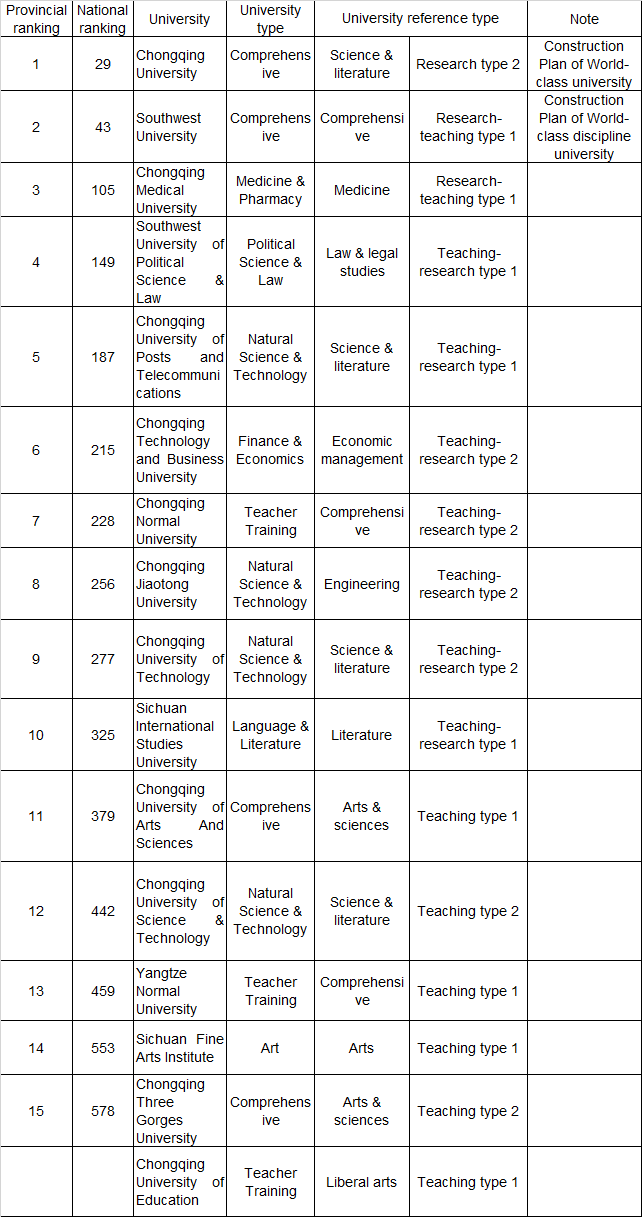
2. Comprehensive Strength Rankings of Universities in Sichuan 2019
33 general undergraduate universities in Sichuan were evaluated in 2019. The teachers’ academic level of universities in Sichuan was 0.7667, ranking 15 in China. The teachers’ performance was 0.8217, ranking 16 in China. 3905 doctoral students graduated in 2018, ranking 8 in China. 148857 undergraduates graduated, ranking 5 in China. 29474 postgraduates graduated in 2017, ranking 7 in China.

3. Comprehensive Strength Rankings of Universities in Guizhou 2019
18 general undergraduate universities in Guizhou were evaluated in 2019. The teachers’ academic level of universities in Guizhou was 0.3020, ranking 28 in China. The teachers’ performance was 0.4792, ranking 30 in China. 121 doctoral students graduated in 2018, ranking 27 in China. 53544 undergraduates graduated, ranking 26 in China. 5703 postgraduates graduated in 2017, ranking 27 in China.
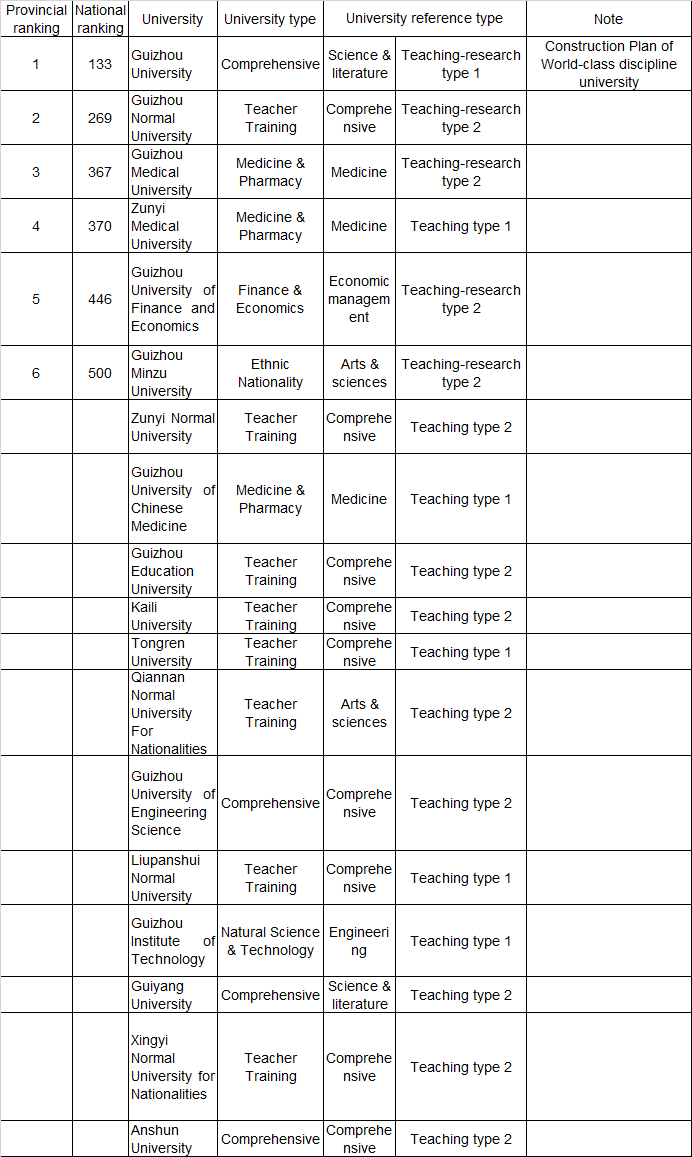
4. Comprehensive Strength Rankings of Universities in Yunnan 2019
20 general undergraduate universities in Yunnan were evaluated in 2019. The teachers’ academic level of universities in Yunnan was 0.4035, ranking 23 in China. The teachers’ performance was 0.5377, ranking 26 in China. 643 doctoral students graduated in 2018, ranking 21 in China. 70161 undergraduates graduated, ranking 21 in China. 11468 postgraduates graduated in 2017, ranking 20 in China.
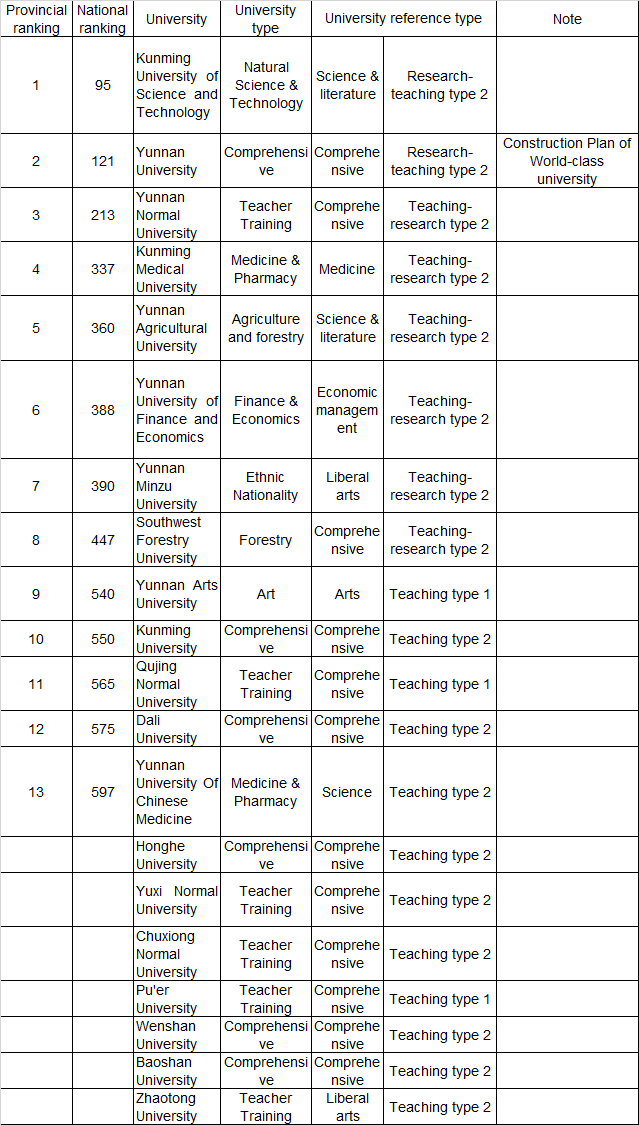
5. Comprehensive Strength Rankings of Universities in Tibet 2019
3 general undergraduate universities in Tibet were evaluated in 2019. The teachers’ academic level of universities in Tibet was 0.2949, ranking 29 in China. The teachers’ performance was 0.5830, ranking 22 in China. 7 doctoral students graduated in 2018, ranking 31 in China. 4309 undergraduates graduated, ranking 31 in China. 561 postgraduates graduated in 2017, ranking 31 in China.
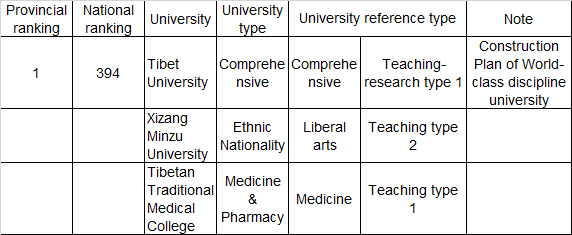
(VI) Provincial Comprehensive Strength Rankings of Universities in Northwest China 2019
Northwest China includes Shaanxi, Gansu, Qinghai, Ningxia Hui Autonomous Region, and Xinjiang Uygur Autonomous Region, in a total of five provincial administrative regions.
1. Comprehensive Strength Rankings of Universities in Shaanxi 2019
34 general undergraduate universities in Shaanxi were evaluated in 2019. The teachers’ academic level of universities in Shaanxi was 0.9926, ranking 7 in China. The teachers’ performance was 1.0643, ranking 7 in China. 5012 doctoral students graduated in 2018, ranking 5 in China. 132733 undergraduates graduated, ranking 8 in China. 32376 postgraduates graduated in 2017, ranking 5 in China.

2. Comprehensive Strength Rankings of Universities in Gansu 2019
16 general undergraduate universities in Gansu were evaluated in 2019. The teachers’ academic level of universities in Gansu was 0.7528, ranking 16 in China. The teachers’ performance was 0.7746, ranking 17 in China. 948 doctoral students graduated in 2018, ranking 18 in China. 60772 undergraduates graduated, ranking 24 in China. 10232 postgraduates graduated in 2017, ranking 22 in China.
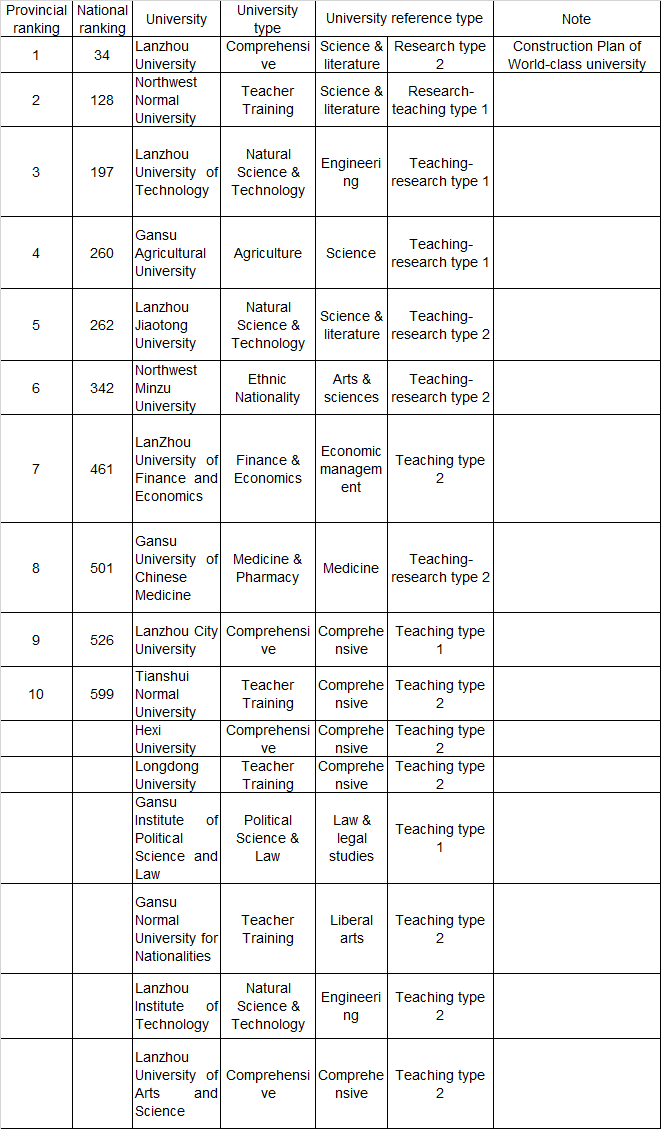
3. Comprehensive Strength Rankings of Universities in Qinghai 2019
3 general undergraduate universities in Qinghai were evaluated in 2019. The teachers’ academic level of universities in Qinghai was 0.2141, ranking 31 in China. The teachers’ performance was 0.4999, ranking 29 in China. 18 doctoral students graduated in 2018, ranking 30 in China. 7645 undergraduates graduated, ranking 30 in China. 1189 postgraduates graduated in 2017, ranking 30 in China.
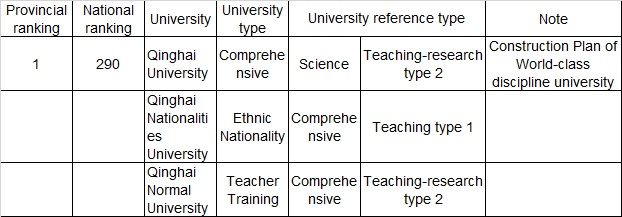
4. Comprehensive Strength Rankings of Universities in Ningxia Hui Autonomous Region 2019
13 general undergraduate universities in Ningxia were evaluated in 2019. The teachers’ academic level of universities in Ningxia was 0.3528, ranking 27 in China. The teachers’ performance was 0.5381, ranking 25 in China. 33 doctoral students graduated in 2018, ranking 29 in China. 11510 undergraduates graduated, ranking 29 in China. 1608 postgraduates graduated in 2017, ranking 28 in China.
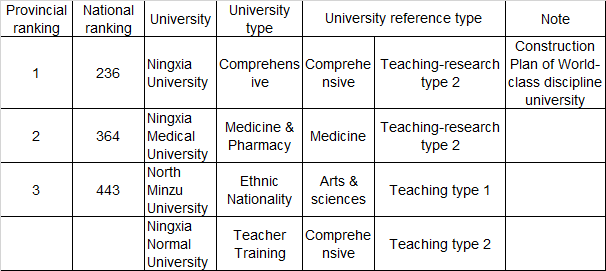
5. Comprehensive Strength Rankings of Universities in Xinjiang Uygur Autonomous Region 2019
12 general undergraduate universities in Xinjiang were evaluated in 2019. The teachers’ academic level of universities in Xinjiang was 0.4727, ranking 19 in China. The teachers’ performance was 0.5987, ranking 20 in China. 280 doctoral students graduated in 2018, ranking 25 in China. 34258 undergraduates graduated, ranking 27 in China. 6518 postgraduates graduated in 2017, ranking 25 in China.
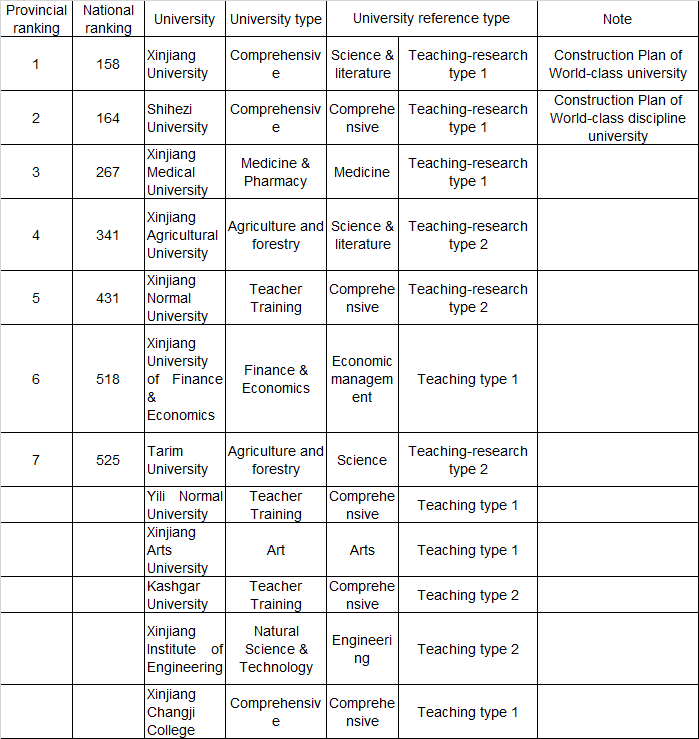
All the data in this paper originated from Choose University & Major – Guidelines for GAOKAO in 2019 written by Wu Shulian and published by China Statistics Press.
Note: Chinese Universities’ Reference Type
The university type is a high summary of university attributes, reflecting the basic characteristics of university. This report covers 2 aspects of university types: the proportion of the subjects in the universities and the scale of the scientific research and academic level. Universities can be classified into different ”categories” and ”types”. The “category” reflects the composition of the university, according to the division of the subject and the proportion of the university in the Ministry of Education. The existing categories usually include comprehensive studies, professionally oriented liberal arts, liberal arts, science, humanities, engineering, agronomy, medicine, economics, law, literature, Physical Culture, art. The type reflects the scientific research scale and the academic level of the university. The existing types are four: research type, research-teaching type, teaching-research type and teaching type. The type of each university is composed of the above-mentioned category and the type. For example, according to the proportion of each subject offered, Peking University is a considered to be a “comprehensive” university.
Another example: According to its proportion of various disciplines, Harbin Institute of Technology is categorized as an engineering university. According to its scale of scientific research and academic level, Harbin Institute of Technology belongs to the research type 2 category and its university type is engineering research.
1. Classification of university types according to scientific research scale and academic level
Table 1 shows the classification standards of Chinese universities according to the scale of research and the level of teachers. The types are divided into research type, research-teaching type, teaching-research type and teaching type. .
Table 1 Chinese university classification criteria (by scientific research scale and academic level)
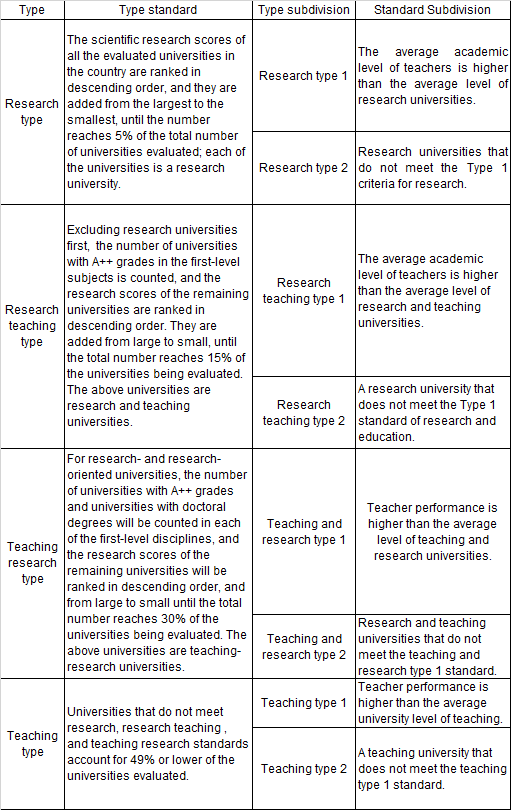
According to the above university classification standards, there are 38 research universities in 2018, 114 research teaching universities, 227 teaching research universities, and 379 teaching universities.
2. University type according to the proportion of subjects
Table 2 shows the university classification criteria determined by the proportion of subjects. In the subject classification determined by the Academic Degrees Committee of the State Council, there are 13 subjects: philosophy, economics, law, education, literature, history, science, engineering, agriculture, medicine, military, management, and art. This book does not evaluate military science. The four subjects of science, engineering, agronomy and medicine are collectively referred to as science in the college entrance examination. The eight subjects of philosophy, economics, law, education, literature, history, management, and art are collectively referred to as liberal arts in the college entrance examination. Science and liberal arts are the customary terms in the college entrance examination.
Table 2 Classification criteria of Chinese universities (according to the proportion of subjects , the 7th revision in February 2019)
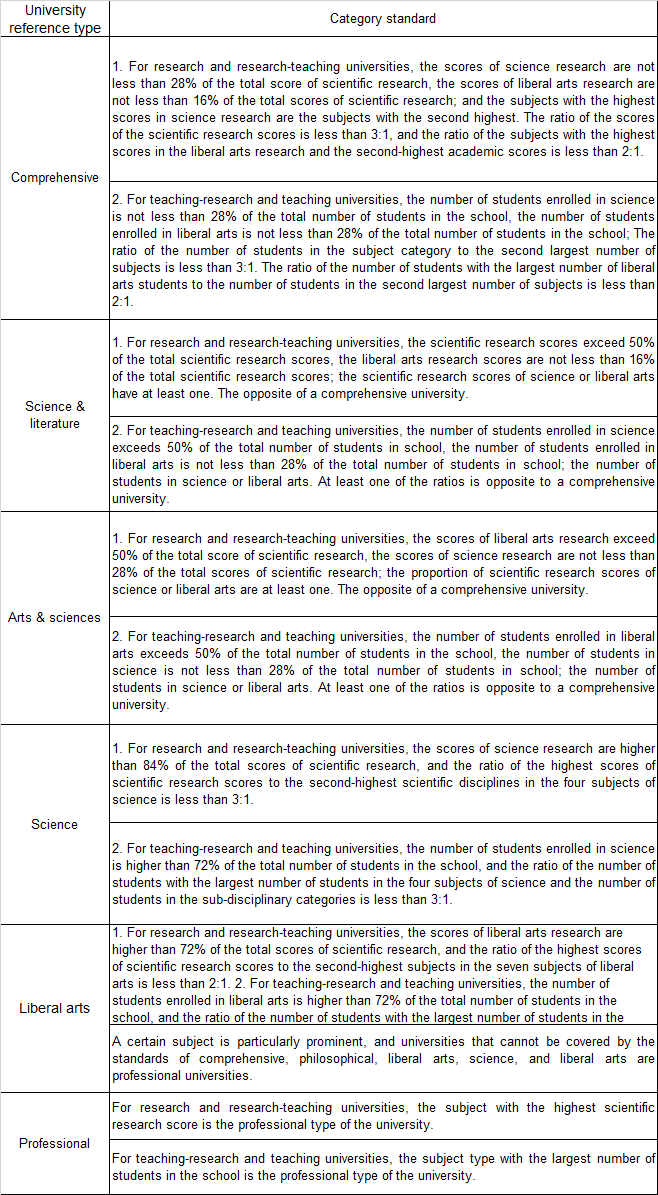
According to the proportion of subjects, the professional universities in Table 1-2 can be divided into science, engineering, agronomy, medicine, philosophy, law, education, literature, history, economics and management. There are 12 categories of art classes; China usually leaves Physical Culture in the education category, while the economic and management categories are relatively similar and are merged into the management category. In the actual classification, the professional universities consist of 13 categories.
According to the above university classification standards, there are 201 comprehensive universities in 2019, 176 liberal arts universities, 52 liberal arts universities, 26 science universities, 44 liberal arts universities, and 259 professional universities. Among the 259 professional universities, there are 84 engineering schools, 1 agronomy school, 71 medical schools, 42 economics and management schools, 7 law schools, 10 literature schools, 14 Physical Culture schools, and 30 art schools.
The distinction between the university classification criteria above for each type of university can be summarized as follows:
Research type: universities with the highest academic level, the most significant scientific research results, and many graduate students.
Research teaching type: Academic level and scientific research results are second only to universities with research universities, graduate students and undergraduate students.
Teaching research type: teaching-oriented, research-assisted, undergraduate teaching, supplemented by postgraduate teaching.
Teaching type: a university with undergraduate teaching.
Comprehensive: Balanced development of arts and sciences, liberal arts and science, with at least two relatively strong subject categories.
Science & literature: the liberal arts and sciences are balanced, the science is stronger than the liberal arts, and the science or liberal arts are less than two subjects.
Arts and sciences: The development between liberal arts and sciences is balanced, liberal arts are stronger than science, and the number of subjects in the filed of liberal arts or science is larger than 2.
Natural science: Science is obviously stronger than liberal arts. At least two of the four subjects of science are strong.
Liberal arts: The liberal arts are obviously stronger than the science, and at least two of the eight subjects of the liberal arts are stronger.
Sciences: Science is obviously stronger than liberal arts. Among the four subjects of science, science is obviously stronger than other subjects.
Engineering: Science is obviously stronger than liberal arts. Among the four subjects of science, engineering is obviously stronger than other subjects.
Agronomy: Science is obviously stronger than liberal arts. Among the four subjects of science, agronomy is obviously stronger than any other subjects.
Medicine: Science is obviously stronger than liberal arts. Among the four subjects of science, medicine is obviously stronger than other subjects.
Economics and Management: The liberal arts are obviously stronger than the science. In the eight subjects of liberal arts, economics or management is obviously stronger than other subjects.
Law: The liberal arts are obviously stronger than the science. Among the eight subjects of liberal arts, law is obviously stronger than other subjects.
Literature: The liberal arts are obviously stronger than the science, and among the eight subjects of the liberal arts, literature is clearly stronger than other subjects.
Physical Culture: Physical Culture majors are significantly stronger than other majors.
Art: Art majors are significantly stronger than other professions.
Author website: www.yaxue.net
Author mailbox: wushulian@vip.sina.com